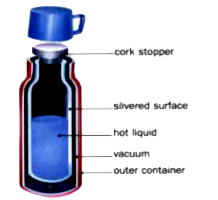Explain how heat transfer is reduced in a thermos flask.
Step-by-Step Solution:
1. Understanding Heat Transfer:
- Heat transfer can occur through three main processes: conduction, convection, and radiation.
2. Heat Transfer by Radiation:
- In a thermos flask, heat transfer by radiation is minimal because the temperature difference between the liquid inside and the outer environment is not significant enough to produce substantial radiation.
3. Heat Transfer by Convection:
- Convection involves the movement of molecules. However, in a thermos flask, the cap is tightly sealed, preventing the movement of air or fluid that would facilitate convection.
4. Heat Transfer by Conduction:
- The primary method of heat transfer that could occur in a thermos flask is conduction. However, the design of the thermos flask includes a vacuum layer between the inner and outer walls.
5. Role of Vacuum:
- Since conduction requires contact between materials, the vacuum between the inner and outer walls of the thermos flask significantly reduces heat transfer. In a vacuum, there are no molecules to transfer heat, thus minimizing conduction.
6. Conclusion:
- Therefore, the combination of minimal radiation, absence of convection, and the vacuum layer effectively reduces heat transfer in a thermos flask, keeping the contents hot or cold for an extended period.
- Heat transfer can occur through three main processes: conduction, convection, and radiation.
- In a thermos flask, heat transfer by radiation is minimal because the temperature difference between the liquid inside and the outer environment is not significant enough to produce substantial radiation.
- Convection involves the movement of molecules. However, in a thermos flask, the cap is tightly sealed, preventing the movement of air or fluid that would facilitate convection.
- The primary method of heat transfer that could occur in a thermos flask is conduction. However, the design of the thermos flask includes a vacuum layer between the inner and outer walls.
- Since conduction requires contact between materials, the vacuum between the inner and outer walls of the thermos flask significantly reduces heat transfer. In a vacuum, there are no molecules to transfer heat, thus minimizing conduction.
- Therefore, the combination of minimal radiation, absence of convection, and the vacuum layer effectively reduces heat transfer in a thermos flask, keeping the contents hot or cold for an extended period.
Topper's Solved these Questions
- HEATBOOK - ICSECHAPTER - HEATEXERCISE - EXERCISE (SECTION II) (Numerical Questions)
5 Videos
- HEATBOOK - ICSECHAPTER - HEATEXERCISE - EXERCISE (PICTURE)
10 Videos
- HEATBOOK - ICSECHAPTER - HEATEXERCISE - EXERCISE (SECTION II) (Short Answer Questions)
7 Videos
- FORCE AND PRESSURE : MOTION BOOK - ICSECHAPTER - FORCE AND PRESSURE : MOTION EXERCISE - EXERCISES (SECTION II) (Picture Study)
4 Videos
- LIGHT ENERGYBOOK - ICSECHAPTER - LIGHT ENERGYEXERCISE - EXERCISE (PICTURE STUDY)
10 Videos
Similar Questions
Explain the Heat Stroke
View SolutionExplain how lubricants help in reducing friction ?
View Solution''A hot liquid' remains hot and a cold liquid remains cold in a thermos flask.'' Explain how ?
View SolutionDraw a labelled diagram of a thermos flask. Explain how the transfer of heat by conduction, convection and radiation is reduced to a minimum in it.
View SolutionLook at the picture of the thermos flask and answer the following question

The outer surface of the inner wall of a thermos flask has a very shiny surface. What effect will this have on heat escaping from a hot liquid inside a thermos flask?
View SolutionWhat type of systes are the following system?
Hot tea placed in a thermos flask.
View SolutionLook at the picture of the thermos flask and answer the following question
 Which means of heat transfer are prevented by having a vacuum between the two walls of thermos flasks?
Which means of heat transfer are prevented by having a vacuum between the two walls of thermos flasks?
View SolutionWhat is heat transfer ? Explain conduction of heat.
View SolutionExplain briefly the process of heat transfer by radiation.
View SolutionName the mode of transfer of heat in the gas
View Solution
